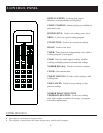
16
COOKING TECHNIQUES (continued)
SHIELDING
Shield food with narrow strips of aluminum foil to prevent overcooking.
Areas that need shielding include poultry wing tips, the ends of poultry legs, and corners of square
baking dishes.
Use only small mounts of aluminum foil, as larger amounts may damage your microwave.
•
•
•
TURNING
Turn foods over midway through cooking to expose all parts to microwave energy.
This is especially important when cooking large foods such as roasts.
•
•
STANDING
Foods cooked in a microwave build up internal heat and continue to cook for a few minutes after
heating stops.
Let foods stand to complete cooking, especially for foods such as cakes and whole vegetables.
Roasts need this time to complete cooking in the center without overcooking the outer areas.
All liquids, such as soup or hot chocolate, should be shaken or stirred when cooking is complete.
When heating baby food, stir well after removing from microwave and test temperature before
serving.
•
•
•
•
•
ADDING MOISTURE
Microwave energy is attracted to water molecules.
Food that is uneven in moisture content should be covered or allowed to stand so that the heat
disperses evenly.
Add a small amount of water to dry food to help it cook.
•
•
•


















